Today, we present a set of 10 postcards for the Italian period piece Beatrice Cenci (Guido Brignone, 1941), with German star Carola Höhn as the title character and Giulio Donadio as her brutal father. It is one of several films portraying the tragic story of the sixteenth century Italian noblewoman Beatrice Cenci. The film was produced by Manenti Film and the cards were published by by Casa editrice Albore in Milan. But how truthful was the film?
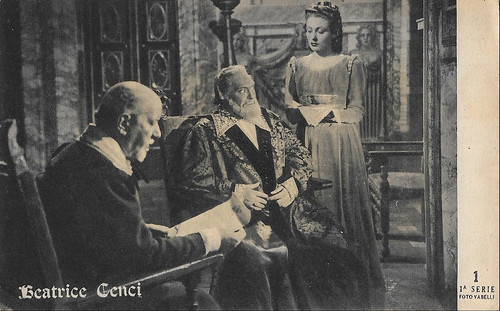
Italian postcard by Casa editrice Albore, Milano, no. 1. Photo: Vaselli / Manenti Film. Publicity still for Beatrice Cenci (Guido Brignone, 1941), with Carola Höhn as Beatrice Cenci and Giulio Donadio as her father.
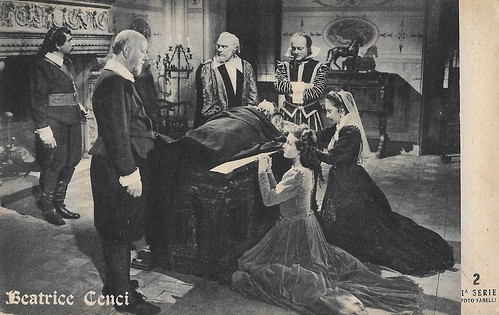
Italian postcard by Casa editrice Albore, Milano, no. 2. Photo: Vaselli / Manenti Film. Publicity still for Beatrice Cenci (Guido Brignone, 1941). In the middle Giulio Donadio as Francesco Cenci, right of him Cenci's son Giacomo (Osvaldo Valenti), and kneeling on the foreground his daughter Beatrice (Carola Höhn).
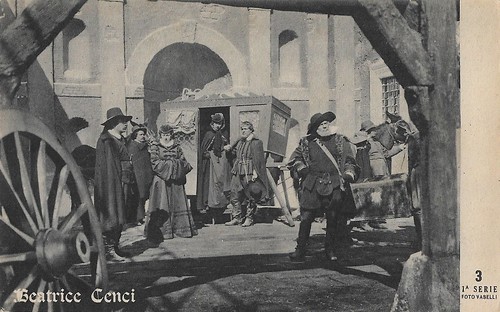
Italian postcard by Casa editrice Albore, Milano, no. 3. Photo: Vaselli / Manenti Film. Publicity still for Beatrice Cenci (Guido Brignone, 1941). Debt-ridden Roman count Francesco Cenci is forced to stay for 7 months in a lonely castle. He forces his family to accompany him.
Beatrice Cenci (Guido Brignone, 1941) was the first sound adaptation of the seven films about the historical character Beatrice Cenci. However, there was a 1926 silent version by Baldassarre Negroni, which was sonorised a few years after. In addition to Carola Höhn as Beatrice and Giulio Donadio as her violent father, the cast included Tina Lattanzi (as Cenci's second wife Lucrezia), Osvaldo Valenti (Cenci's son Giacomo), Enzo Fiermonte (Beatrice's lover Olimpio), Elli Parvo (Cenci's mistress Angela), Luigi Pavese, and others.
Beatrice Cenci (Guido Brignone, 1941) was shot at the studios of the Centro Sperimentale di Cinematografia in Rome. The sets were designed by Guido Fiorini, while Gino Sesani took care of the costumes.The film was cinematographed by Jan Stallich, scripted by Tommaso Smith, and edited by Vincenzo Zampi.
The action of the film takes place at the end of the sixteenth century between Abruzzo and Rome. The Roman Count Francesco Cenci (Giulio Donadio), a dissolute and violent man, is condemned for debts to seven months of exile to spend in a distant fortress of Abruzzo.
A true tyrant, Cenci demands that the members of his family accompany him, which pains especially his daughter Beatrice (Carola Höhn), forced to leave her boyfriend Olimpio (Enzo Fiermonte) behind to follow her father. Subjected to the harshest humiliations by her cruel father, she asks for help from Olimpio, who decides to free her and arrives at the fortress with the intent to kidnap her. The plan fails and the young man remains locked inside the castle.
The following morning, the corpse of Count Cenci is found in a ravine, under the window of his room. Misfortune or crime? The process begins, during which the suspicions now weigh on one, then on the other family member.
Beatrice, the only one who had publicly opposed her father's authority, is the one on whom the main clues seem to fall, clues that assume the importance of proof, and she is therefore condemned to beheaded. When the truth, which proves the innocence of Beatrice, makes its way, the sentence has already been executed.
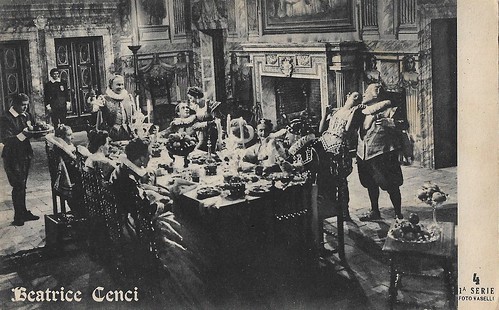
Italian postcard by Casa editrice Albore, Milano, no. 4. Photo: Vaselli / Manenti Film. Publicity still for Beatrice Cenci (Guido Brignone, 1941). Francesco Cenci is a bonvivant and spendthrift, notorious for his embezzlements.
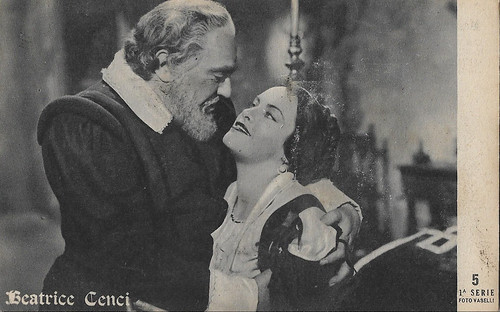
Italian postcard by Casa editrice Albore, Milano, no. 5. Photo: Vaselli / Manenti Film. Publicity still for Beatrice Cenci (Guido Brignone, 1941). Francesco Cenci (Giulio Donadio) and his mistress Angela (Elli Parvo).
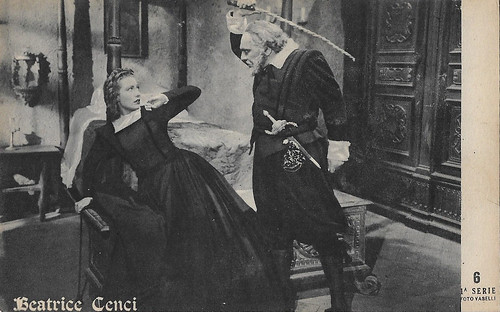
Italian postcard by Casa editrice Albore, Milano, no. 6. Photo: Vaselli / Manenti Film. Publicity still for Beatrice Cenci (Guido Brignone, 1941). Francesco Cenci (Giulio Donadio) whips his daughter Beatrice (Carola Höhn) when he finds out she has communicated about the tyrant to the outside world.
Beatrice Cenci has been the subject of a number of literary works. Percy Bysshe Shelley composed his verse drama The Cenci: A Tragedy in Five Acts at Rome and at Villa Valsovano near Livorno, in 1819. It is well known as a magnificent piece of writing, although the author adopts a purely fictitious version of the story. Nor is Francesco Domenico Guarrazzi’s novel, Beatrice Cenci (1872), more trustworthy. The first attempt to deal with the subject on documentary evidence is A. Bertolotti’s Francesco Cenci e la sua famiglia (1879), containing a number of interesting documents which place the events in their true light.
But how truthful was the film version of 1941, and how innocent was Beatrice?
Beatrice Cenci was a young Roman noblewoman, born in Rome in 1577. She was the daughter of Count Francesco Cenci (1549–1598), the bastard son of a priest, and a man of great wealth but dissolute habits and violent temper. He seems to have been guilty of various offences and to have got off with short terms of imprisonment by bribery; but the monstrous cruelty which popular tradition has attributed to him is purely legendary.
His first wife, Ersilia Santa Croce, bore him twelve children, and nine years after her death he married Lucrezia Petroni, a widow with three daughters, by whom he had no offspring. He was very quarrelsome and lived on the worst possible terms with his children, who, however, were all of them more or less disreputable. He kept various mistresses and was even prosecuted for unnatural vice, but his sons were equally dissolute.
His harsh treatment of his daughter Beatrice was probably due to his discovery that she had had an illegitimate child as the result of an intrigue with one of his stewards, but there is no evidence that he tried to commit incest with her, as has been alleged. The eldest son Giacomo was a riotous, dishonest young scoundrel, who cheated his own father and even attempted to murder him in 1595. Two other sons, Rocco and Cristoforo, both of them notorious rakes, were killed in brawls.
Finally Francesco’s wife Lucrezia and his children Giacomo, Bernardo and Beatrice, assisted by a certain Monsignor Guerra, plotted to murder him. Two bravos were hired (one of them named Olimpio, according to Bertolotti, was probably Beatrice’s lover), and Francesco was assassinated while asleep in his castle of Petrella in the kingdom of Naples in 1598.
Giacomo afterwards had one of the bravos murdered, but the other was arrested by the Neapolitan authorities and confessed everything. Information having been communicated to Rome, the whole of the Cenci family were arrested early in 1599; but the story of the hardships they underwent in prison is greatly exaggerated. Guerra escaped; Lucrezia, Giacomo and Bernardo confessed the crime; and Beatrice, who at first denied everything, even under torture, also ended by confessing.
Great efforts were made to obtain mercy for the accused, but the crime was considered too heinous, and pope Clement VIII refused to grant a pardon. At dawn on 11 September 1599, they were taken to Sant'Angelo Bridge, where the scaffold was usually built. Giacomo, after having been tortured with red-hot pincers, was killed with a mace, drawn and quartered. First Lucrezia and finally Beatrice were beheaded. The 12-year-old Bernardo’s penalty, on account of his youth, was commuted to perpetual imprisonment, and after a year’s confinement he was pardoned.
The property of the family was confiscated and given to the Pope's family. Beatrice was buried in the church of San Pietro in Montorio. Beatrice has become a symbol to the people of Rome of resistance against the arrogant aristocracy, and a legend arose. It is related that every year on the night before the anniversary of her death, she comes back to the bridge where she was executed, carrying her severed head.
Beatrice Cenci (Guido Brignone, 1941) was followed by two more screen versions in the next decades. The first was Beatrice Cenci (Riccardo Freda, 1956) with Micheline Presle as Beatrice, Gino Cervi as her father, and Fausto Tozzi as Olimpio. In 1969, director Lucio Fulci made a new film version, Beatrice Cenci/The Conspiracy of Torture (1969), starring Tomas Milian, Adrienne Larussa as Beatrice and Georges Wilson as her father. The film follows the historical events of Cenci's life very closely. Fulci said it was one of his favourite films, even though he later became known for excessively gory horror films.
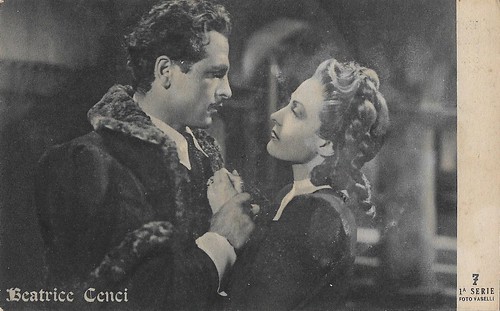
Italian postcard by Casa editrice Albore, Milano, no. 7. Photo: Vaselli / Manenti Film. Publicity still for Beatrice Cenci (Guido Brignone, 1941). Here Beatrice (Carola Höhn) and her lover, Olimpio (Enzo Fiermonte), who helps her killing her brutal father.
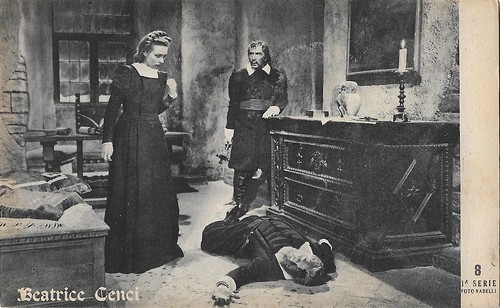
Italian postcard by Casa editrice Albore, Milano, no. 8. Photo: Vaselli / Manenti Film. Publicity still for Beatrice Cenci (Guido Brignone, 1941). The blacksmith Il Catalano (Luigi Pavese) has slain Cenci. Beatrice (Carola Höhn) watches her dead father (Giulio Donadio).
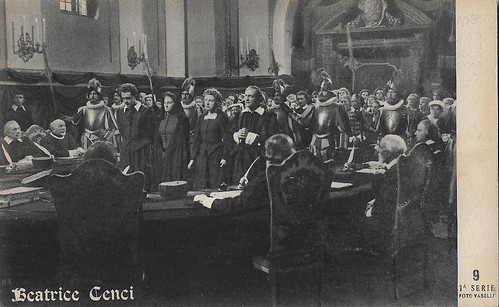
Italian postcard by Casa editrice Albore, Milano, no. 9. Photo: Vaselli / Manenti Film. Publicity still for Beatrice Cenci (Guido Brignone, 1941). The trial.

Italian postcard by Casa editrice Albore, Milano, no. 10. Photo: Vaselli / Manenti Film. Publicity still for Beatrice Cenci (Guido Brignone, 1941). The beheading of Beatrice Cenci.
Sources: Roberto Chiti, Enrico Lancia, and Roberto Pop (I film: Tutti i film italiani dal 1930 al 1944 - Italian), Encyclopaedia Britannica, Wikipedia (Italian and English) and IMDb.

Italian postcard by Casa editrice Albore, Milano, no. 1. Photo: Vaselli / Manenti Film. Publicity still for Beatrice Cenci (Guido Brignone, 1941), with Carola Höhn as Beatrice Cenci and Giulio Donadio as her father.

Italian postcard by Casa editrice Albore, Milano, no. 2. Photo: Vaselli / Manenti Film. Publicity still for Beatrice Cenci (Guido Brignone, 1941). In the middle Giulio Donadio as Francesco Cenci, right of him Cenci's son Giacomo (Osvaldo Valenti), and kneeling on the foreground his daughter Beatrice (Carola Höhn).

Italian postcard by Casa editrice Albore, Milano, no. 3. Photo: Vaselli / Manenti Film. Publicity still for Beatrice Cenci (Guido Brignone, 1941). Debt-ridden Roman count Francesco Cenci is forced to stay for 7 months in a lonely castle. He forces his family to accompany him.
Innocently executed
Beatrice Cenci (Guido Brignone, 1941) was the first sound adaptation of the seven films about the historical character Beatrice Cenci. However, there was a 1926 silent version by Baldassarre Negroni, which was sonorised a few years after. In addition to Carola Höhn as Beatrice and Giulio Donadio as her violent father, the cast included Tina Lattanzi (as Cenci's second wife Lucrezia), Osvaldo Valenti (Cenci's son Giacomo), Enzo Fiermonte (Beatrice's lover Olimpio), Elli Parvo (Cenci's mistress Angela), Luigi Pavese, and others.
Beatrice Cenci (Guido Brignone, 1941) was shot at the studios of the Centro Sperimentale di Cinematografia in Rome. The sets were designed by Guido Fiorini, while Gino Sesani took care of the costumes.The film was cinematographed by Jan Stallich, scripted by Tommaso Smith, and edited by Vincenzo Zampi.
The action of the film takes place at the end of the sixteenth century between Abruzzo and Rome. The Roman Count Francesco Cenci (Giulio Donadio), a dissolute and violent man, is condemned for debts to seven months of exile to spend in a distant fortress of Abruzzo.
A true tyrant, Cenci demands that the members of his family accompany him, which pains especially his daughter Beatrice (Carola Höhn), forced to leave her boyfriend Olimpio (Enzo Fiermonte) behind to follow her father. Subjected to the harshest humiliations by her cruel father, she asks for help from Olimpio, who decides to free her and arrives at the fortress with the intent to kidnap her. The plan fails and the young man remains locked inside the castle.
The following morning, the corpse of Count Cenci is found in a ravine, under the window of his room. Misfortune or crime? The process begins, during which the suspicions now weigh on one, then on the other family member.
Beatrice, the only one who had publicly opposed her father's authority, is the one on whom the main clues seem to fall, clues that assume the importance of proof, and she is therefore condemned to beheaded. When the truth, which proves the innocence of Beatrice, makes its way, the sentence has already been executed.

Italian postcard by Casa editrice Albore, Milano, no. 4. Photo: Vaselli / Manenti Film. Publicity still for Beatrice Cenci (Guido Brignone, 1941). Francesco Cenci is a bonvivant and spendthrift, notorious for his embezzlements.

Italian postcard by Casa editrice Albore, Milano, no. 5. Photo: Vaselli / Manenti Film. Publicity still for Beatrice Cenci (Guido Brignone, 1941). Francesco Cenci (Giulio Donadio) and his mistress Angela (Elli Parvo).

Italian postcard by Casa editrice Albore, Milano, no. 6. Photo: Vaselli / Manenti Film. Publicity still for Beatrice Cenci (Guido Brignone, 1941). Francesco Cenci (Giulio Donadio) whips his daughter Beatrice (Carola Höhn) when he finds out she has communicated about the tyrant to the outside world.
An illegitimate child
Beatrice Cenci has been the subject of a number of literary works. Percy Bysshe Shelley composed his verse drama The Cenci: A Tragedy in Five Acts at Rome and at Villa Valsovano near Livorno, in 1819. It is well known as a magnificent piece of writing, although the author adopts a purely fictitious version of the story. Nor is Francesco Domenico Guarrazzi’s novel, Beatrice Cenci (1872), more trustworthy. The first attempt to deal with the subject on documentary evidence is A. Bertolotti’s Francesco Cenci e la sua famiglia (1879), containing a number of interesting documents which place the events in their true light.
But how truthful was the film version of 1941, and how innocent was Beatrice?
Beatrice Cenci was a young Roman noblewoman, born in Rome in 1577. She was the daughter of Count Francesco Cenci (1549–1598), the bastard son of a priest, and a man of great wealth but dissolute habits and violent temper. He seems to have been guilty of various offences and to have got off with short terms of imprisonment by bribery; but the monstrous cruelty which popular tradition has attributed to him is purely legendary.
His first wife, Ersilia Santa Croce, bore him twelve children, and nine years after her death he married Lucrezia Petroni, a widow with three daughters, by whom he had no offspring. He was very quarrelsome and lived on the worst possible terms with his children, who, however, were all of them more or less disreputable. He kept various mistresses and was even prosecuted for unnatural vice, but his sons were equally dissolute.
His harsh treatment of his daughter Beatrice was probably due to his discovery that she had had an illegitimate child as the result of an intrigue with one of his stewards, but there is no evidence that he tried to commit incest with her, as has been alleged. The eldest son Giacomo was a riotous, dishonest young scoundrel, who cheated his own father and even attempted to murder him in 1595. Two other sons, Rocco and Cristoforo, both of them notorious rakes, were killed in brawls.
Finally Francesco’s wife Lucrezia and his children Giacomo, Bernardo and Beatrice, assisted by a certain Monsignor Guerra, plotted to murder him. Two bravos were hired (one of them named Olimpio, according to Bertolotti, was probably Beatrice’s lover), and Francesco was assassinated while asleep in his castle of Petrella in the kingdom of Naples in 1598.
Giacomo afterwards had one of the bravos murdered, but the other was arrested by the Neapolitan authorities and confessed everything. Information having been communicated to Rome, the whole of the Cenci family were arrested early in 1599; but the story of the hardships they underwent in prison is greatly exaggerated. Guerra escaped; Lucrezia, Giacomo and Bernardo confessed the crime; and Beatrice, who at first denied everything, even under torture, also ended by confessing.
Great efforts were made to obtain mercy for the accused, but the crime was considered too heinous, and pope Clement VIII refused to grant a pardon. At dawn on 11 September 1599, they were taken to Sant'Angelo Bridge, where the scaffold was usually built. Giacomo, after having been tortured with red-hot pincers, was killed with a mace, drawn and quartered. First Lucrezia and finally Beatrice were beheaded. The 12-year-old Bernardo’s penalty, on account of his youth, was commuted to perpetual imprisonment, and after a year’s confinement he was pardoned.
The property of the family was confiscated and given to the Pope's family. Beatrice was buried in the church of San Pietro in Montorio. Beatrice has become a symbol to the people of Rome of resistance against the arrogant aristocracy, and a legend arose. It is related that every year on the night before the anniversary of her death, she comes back to the bridge where she was executed, carrying her severed head.
Beatrice Cenci (Guido Brignone, 1941) was followed by two more screen versions in the next decades. The first was Beatrice Cenci (Riccardo Freda, 1956) with Micheline Presle as Beatrice, Gino Cervi as her father, and Fausto Tozzi as Olimpio. In 1969, director Lucio Fulci made a new film version, Beatrice Cenci/The Conspiracy of Torture (1969), starring Tomas Milian, Adrienne Larussa as Beatrice and Georges Wilson as her father. The film follows the historical events of Cenci's life very closely. Fulci said it was one of his favourite films, even though he later became known for excessively gory horror films.

Italian postcard by Casa editrice Albore, Milano, no. 7. Photo: Vaselli / Manenti Film. Publicity still for Beatrice Cenci (Guido Brignone, 1941). Here Beatrice (Carola Höhn) and her lover, Olimpio (Enzo Fiermonte), who helps her killing her brutal father.

Italian postcard by Casa editrice Albore, Milano, no. 8. Photo: Vaselli / Manenti Film. Publicity still for Beatrice Cenci (Guido Brignone, 1941). The blacksmith Il Catalano (Luigi Pavese) has slain Cenci. Beatrice (Carola Höhn) watches her dead father (Giulio Donadio).

Italian postcard by Casa editrice Albore, Milano, no. 9. Photo: Vaselli / Manenti Film. Publicity still for Beatrice Cenci (Guido Brignone, 1941). The trial.

Italian postcard by Casa editrice Albore, Milano, no. 10. Photo: Vaselli / Manenti Film. Publicity still for Beatrice Cenci (Guido Brignone, 1941). The beheading of Beatrice Cenci.
Sources: Roberto Chiti, Enrico Lancia, and Roberto Pop (I film: Tutti i film italiani dal 1930 al 1944 - Italian), Encyclopaedia Britannica, Wikipedia (Italian and English) and IMDb.
No comments:
Post a Comment